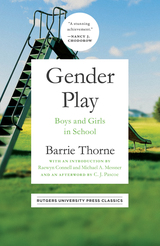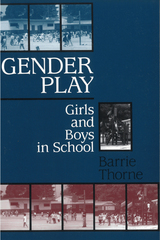3 books by Thorne, Barrie

Feminist Sociology
Life Histories of a Movement
Edited by Barbara Laslett and Barrie Thorne
Rutgers University Press, 1997
This collection of thirteen life stories recaptures the history of a political and intellectual movement that created feminist sociology as a field of inquiry. As the editors' introduction notes, the life history is a crucial tool for sociological thought. Life histories can be a bridge between individual experience and codified knowledge, between human agency and social structure. Life histories can enhance social theory by revealing categories of meaning usually submerged in the conventions of social science. The authors in this volume, all sociologists who have had great impact upon the field in which they write, show how personal relationships, experiences of inequality, and professional conflict and camaraderie interweave with the formation of social theory, political movements, and intellectual thought. The book makes a powerful impression upon anyone who has struggled with the relationship between social theory and everyday life. -- Accessible, lively articles that combine personal narrative with sociological theory. -- Contributors are some of the leading voices in feminist sociology.
[more]

Gender Play
Boys and Girls in School
Barrie Thorne
Rutgers University Press, 2024
When it first appeared in 1993, Barrie Thorne’s Gender Play: Girls and Boys in School became an instant classic in the budding fields of feminist sociology and childhood studies. Through detailed first-hand observations of fourth and fifth graders at play, she investigated questions like: Why do girls and boys tend to self-segregate in the schoolyard? What can playful teasing and ritualized games like “cooties” and “chase and kiss” teach us about how children perform gendered identities? And how do children articulate their own conceptions of gender, distinct from those proscribed by the adult world?
A detailed and perceptive ethnography told with compassion and humor, Gender Play immerses readers in the everyday lives of a group of working-class children to examine the social interactions that shape their gender identities. This new Rutgers Classic edition of Gender Play contains an introduction from leading sociologists of gender Michael A. Messner and Raewyn Connell that places Thorne’s innovative research in historical context. It also includes a new afterword by one of Thorne’s own students, acclaimed sociologist C.J. Pascoe, reflecting on both the lasting influence of Thorne’s work and the ways that American children’s understandings of gender have shifted in the past thirty years.
A detailed and perceptive ethnography told with compassion and humor, Gender Play immerses readers in the everyday lives of a group of working-class children to examine the social interactions that shape their gender identities. This new Rutgers Classic edition of Gender Play contains an introduction from leading sociologists of gender Michael A. Messner and Raewyn Connell that places Thorne’s innovative research in historical context. It also includes a new afterword by one of Thorne’s own students, acclaimed sociologist C.J. Pascoe, reflecting on both the lasting influence of Thorne’s work and the ways that American children’s understandings of gender have shifted in the past thirty years.
[more]

Gender Play
Girls and Boys in School
Thorne, Barrie
Rutgers University Press, 1993
You see it in every schoolyard: the girls play only with the girls, the boys play only with the boys. Why? And what do the kids think about this? Breaking with familiar conventions for thinking about children and gender, Gender Play develops fresh insights into the everyday social worlds of kids in elementary schools in the United States. Barrie Thorne draws on her daily observations in the classroom and on the playground to show how children construct and experience gender in school. With rich detail,she looks at the "play of gender" in the organization of groups of kids and activities - activities such as "chase-and-kiss," "cooties," "goin' with" and teasing.
Thorne observes children in schools in working-class communities, emphasizing the experiences of fourth and fifth graders. Most of the children she observed were white, but a sizable minority were Latino, Chicano, or African American. Thorne argues that the organization and meaning of gender are influenced by age, ethnicity, race, sexuality, and social class, and that they shift with social context. She sees gender identity not through the lens of individual socialization or difference, but rather as a social process involving groups of children. Thorne takes us on a fascinating journey of discovery, provides new insights about children, and offers teachers practical suggestions for increasing cooperative mixed-gender interaction.
Thorne observes children in schools in working-class communities, emphasizing the experiences of fourth and fifth graders. Most of the children she observed were white, but a sizable minority were Latino, Chicano, or African American. Thorne argues that the organization and meaning of gender are influenced by age, ethnicity, race, sexuality, and social class, and that they shift with social context. She sees gender identity not through the lens of individual socialization or difference, but rather as a social process involving groups of children. Thorne takes us on a fascinating journey of discovery, provides new insights about children, and offers teachers practical suggestions for increasing cooperative mixed-gender interaction.
[more]
READERS
Browse our collection.
PUBLISHERS
See BiblioVault's publisher services.
STUDENT SERVICES
Files for college accessibility offices.
UChicago Accessibility Resources
home | accessibility | search | about | contact us
BiblioVault ® 2001 - 2024
The University of Chicago Press









